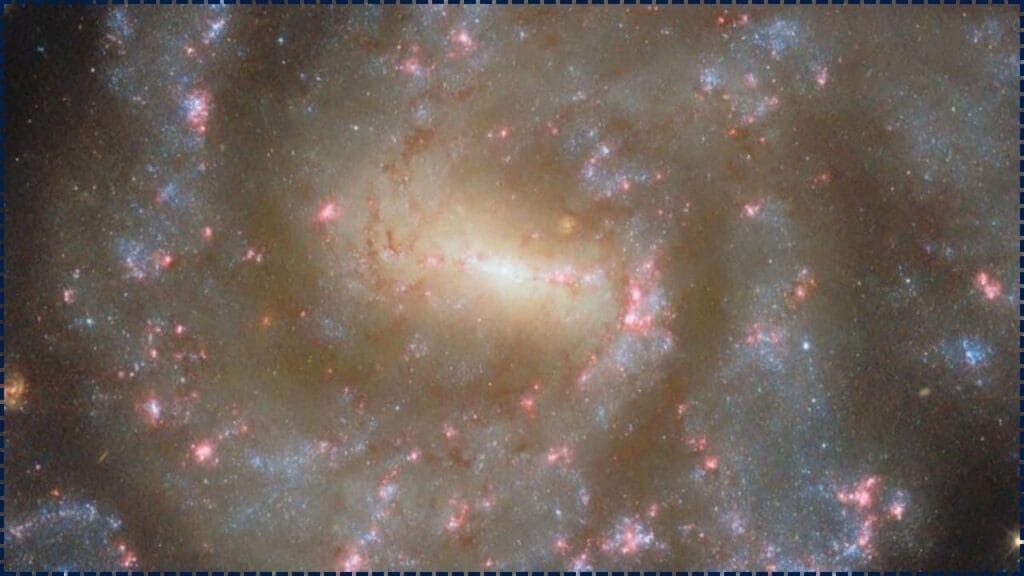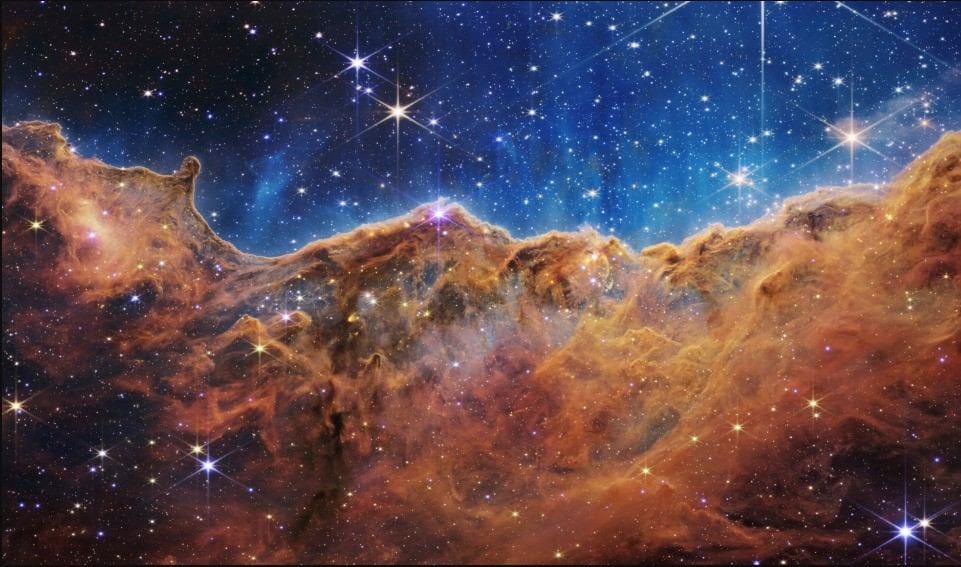Prepare to be amazed! From 64 million light-years away, Hubble has captured a stunning new photo of a galaxy that is truly a cosmic gem, lighting up both our skies and our imaginations. On June 6, 2025, both NASA and the European Space Agency (ESA) shared this absolutely awe-inspiring image with the world.
The photo reveals the incredible beauty of the barred spiral galaxy NGC 685, located in the constellation Eridanus. What makes this image so special is how it’s absolutely brimming with bright, newborn star clusters. These are like cosmic nurseries where baby stars are just beginning their long lives. You can also see glowing H II gas clouds, which are vast areas of hydrogen gas that are energized by these young, hot stars. This photo is a wonderful reminder of the constant creation and breathtaking beauty happening across our universe, inviting all of us to marvel at the wonders beyond our world.

This isn’t just eye candy—it’s a science-packed snapshot of how galaxies give birth to stars. We’ll break down what it shows, why it matters, how astronomers study it, and what it means for all of us—from curious kids to seasoned space pros.
Hubble’s Stunning New Galaxy Photo
| Feature | Details |
|---|---|
| Galaxy Name | NGC 685 — a barred spiral galaxy in Eridanus, ~64 Mly from Earth (science.nasa.gov). |
| Phys. Size & Type | About 74,000 light-years across, roughly half the size of the Milky Way; classified as SB(rs)d . |
| Star‑Forming Regions | Dozens of bright blue star clusters + glowing pink H II nebulae . |
| Gas-to-Star Rate | Converts ~0.42 ☉ of gas into stars per year . |
| Observation Tools | Captured via Hubble’s WFC3 (UV/visible/IR), paired with JWST & ALMA data . |
| Science Goals | Cataloging up to 50,000 H II regions & 100,000 star clusters across nearby galaxies . |
| Official Source | NASA Hubble Mission Team |
The Hubble Space Telescope has captured a truly dazzling new image of the galaxy NGC 685, which is located an incredible 64 million light-years away from us! This image reveals a barred spiral galaxy that is absolutely bursting with star-forming energy.
The sparkling blue clusters and glowing pink regions you see are actually snapshots of cosmic creation – brand new stars being born! This image is part of a larger, coordinated study that’s carefully cataloging tens of thousands of these stellar nurseries across the universe. By combining Hubble’s observations with data from the James Webb Space Telescope (JWST) and the Atacama Large Millimeter/submillimeter Array (ALMA), scientists are making incredible breakthroughs in our understanding of how galaxies grow and evolve.
This image offers us not just wonder and awe, but also a deep sense of connection to the vastness of the cosmos, and it provides invaluable scientific knowledge for all of humanity.

Why the NGC 685 Image Is a Cosmic Game‑Changer
1. Barred Spiral, Stellar Nursery
NGC 685 has a bright central bar—a structure similar to our Milky Way’s—that helps funnel gas into the spiral arms, fueling intense star formation. Hubble’s sharp detail highlights glowing blue clusters and pink H II zones, which are cosmic twilight zones where stars are brand new (science.nasa.gov).
2. Star‑Birth in Motion
Those pink H II regions are gas clouds lit up by young, massive stars. They shine for a short time and then spread their light across space. In NGC 685, astronomers can see 50,000 of them, each a bustling star nursery.
3. Gas-to-Star Efficiency
At ~0.42 solar masses per year, NGC 685 isn’t a star factory powerhouse—but it’s steady, and tracking that helps astronomers understand star formation across cosmic types .
4. Multi‑Wavelength Teamwork
- Hubble: captures visible and UV light from stars.
- JWST: peers into the dusty veils.
- ALMA: spots cold gas radio signals, the raw materials for star making.
Understanding the Process: A Hubble’s Stunning New Galaxy Photo Guide
- Select Target Galaxies: Choose face-on barred spirals like NGC 685, where star formation is vivid.
- Use Multi‑Filter Imaging: Hubble’s WFC3 camera captures light across UV, visible, and IR bands.
- Process and Color Code: Different wavelengths are colorized—blues for young stars, pinks for ionized gas.
- Count Stars & Clouds: Scientists tally clusters and H II zones to study star-formation conditions.
- Add JWST & ALMA Data: Integrate infrared and radio observations for a full 3D map of star birth.
- Publish & Compare: Data is shared with the global science community—to model galaxy evolution.
Why It Matters to You
- For young observers: it’s like seeing cosmic fireworks—stars exploding into existence.
- For amateur astronomers: a teachable moment on barred spirals and how they ignite.
- For pros: deeper insight into how galactic features shape star growth and matter recycling.
- For culture lovers: it sparks awe, connection, and reminders of our own sky‑stories.
Related Links
Confirmed: Massive “White Gold” Discovery in Nevada Could Reshape America’s Energy Future
Saharan Dust Cloud Reaches U.S. – Check How It Could Fuel Hurricane Activity This Summer
Native‑Inspired Reflection
In many Native American traditions, the concepts of birth and renewal are seen as powerful and interconnected cycles. These cycles beautifully tie together the sky, the soil, and the human spirit. The stunning image of galaxy NGC 685 perfectly mirrors this cosmic circle of life. It shows new stars being born, radiating warmth and light amidst the vast stardust.
This image reminds us that our own human stories are deeply connected to the light of distant stars and the grand, rhythmic dance of the cosmos. Just as new stars emerge from stardust, we too are part of a continuous cycle of growth, change, and renewal. It’s a humbling and inspiring reminder of our place in the universe.
Takeaway Tips for Stargazers, Educators & Press
- Use free NASA tools: NASA’s Hubble site features interactive video, 3D models, and activities.
- Share with kids: Let them color-code galaxy photos—discover STEM and cultural meaning.
- Include cultural context: Pair images with Indigenous sky stories and seasonal ties.
- Watch for follow-up: Deep dive with JWST & ALMA announcements coming soon .
FAQs
Q: How far is 64 million light‑years?
A: It means we’re seeing NGC 685 as it was 64 million years ago—back when dinosaurs still roamed Earth!
Q: Why pink and blue?
A: Blue = young, hot stars. Pink = H II regions—clouds lit by star UV light.
Q: What’s a barred spiral galaxy?
A: It’s a galaxy where spiral arms sprout from a central bar—a galaxy like ours, but a bit smaller.
Q: Could planets form here?
A: Possibly. Stars need to mature first—but these nurseries plant seeds for future solar systems.
Q: How unusual is this?
A: Not super rare, but catalogs of 50,000 H II regions are huge progress in galaxy science .








